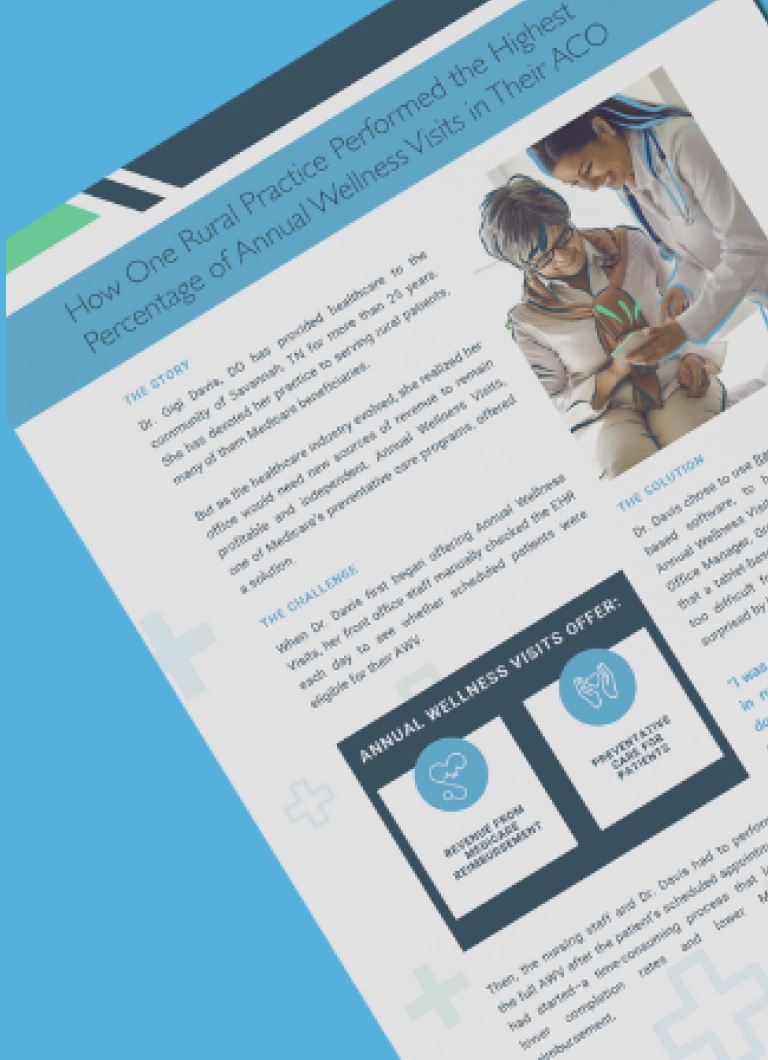
Talk with a ChartSpan Representative Today!
Our team is ready to help you improve patient care and outcomes.
Blog
MythBusters: Annual Wellness Visits Require “A Visit”
Top Myths about Medicare’s Annual Wellness Visit Benefit
Nearly 10 years ago, CMS announced that Medicare patients would have the opportunity to benefit from Annual Wellness Visits (AWVs), which included the creation of a personalized care plan to help patients focus on preventative care practices and holistic patient wellness. To compensate physicians for the time required to create these plans, CMS simultaneously created several new billable codes.
It sounded like a win-win for everyone. So why are so many providers not offering these services and less than 20% of Medicare beneficiaries completing AWVs so many years later?
Perhaps part of the reason is the name given to this program: annual wellness “visits.” AWVs don’t actually require a “visit” to occur. It is one of the most common misunderstandings among both physicians and patients that has led to millions of Medicare patients missing the many benefits related to AWVs and thousands of physicians missing valuable revenue opportunities.
By conducting AWVs, physicians are able to build proactive patient care plans and ensure all necessary screenings are done, which not only generates additional revenue but also ensures they are able to proactively address any emerging health issues. Patients gain a better understanding of healthier living practices and are better equipped to avoid costly complications. Other winners when AWVs are completed include Medicare and accountable care organizations. According to a report in the American Journal of Managed Care, March 2019, AWVs were associated with significantly reduced spending on hospital acute care and outpatient services, a 5.7% reduction in total healthcare costs, and higher likelihood of receiving screenings for fall risk and depression.
In this blog, ChartSpan, the largest care coordination provider in the country, dives into some of the most popular myths related to AWVs.
Myth #1: AWVs Are the Same as Annual Physical Exams
A surprising number of physician practices believe an AWV requires a physical exam. These same practices are all too familiar with the reality that Medicare does not reimburse for an annual physical — and are consequently hesitant to adopt a program that reduces the amount of time they have available to treat sick patients.
What they don’t realize is that an AWV is actually a questionnaire, not a physical, and the provider is able to use the answers from the questionnaire to build a comprehensive care plan for the patient. In addition, the AWV is billable - codes G0438 and G0439.
The distinction between annual physicals and AWVs is confusing to doctors and patients alike. The Washington Post reports that some patients spend as much as $400 for an annual physical that they wrongly assume is covered by their Medicare insurance.
Myth #2: AWVs Must Be Performed by a Doctor
Every doctor’s time is finite and valuable. Informational appointments, like completing an AWV questionnaire, can be perceived as an administrative task that takes away from a physician’s time treating patients. Therefore, CMS guidelines allow other certified health professionals to conduct an AWV, freeing doctors’ schedules while providing preventative services for patients.
An array of licensed professionals or a team of licensed professionals under the direct supervision of a doctor can conduct an AWV. This includes:
- Physician assistants
- Nurse practitioners
- Certified clinical nurse specialists
- Health educators
- Registered dieticians
- Any group of healthcare professionals.
In other words, as long as a doctor is in the office, practices can perform AWVs using a variety of personnel, creating more opportunities to promote patient well-being without inundating doctors’ schedules with informational meetings.
Myth #3: AWVs Don’t Produce Significant Revenue
Many providers are struggling to generate sustainable revenue in a shifting healthcare sector, but they are missing the opportunities afforded by modern Medicare priorities. Holistically, there is a cultural shift away from acute care and toward preventive measures, and Medicare is using its funding to support this transition.
Doctors can bill $175 on average for a patient’s initial AWV, and another $115 on average for subsequent AWVs. Unsure if their patient is on an Initial Wellness Visit (G0438) or Subsequent Wellness Visit (G0439), many providers opt for the lower billing code, often leaving approximately $60 on the table.
To help its customers optimize reimbursement dollars through a more comprehensive eligibility technology, ChartSpan connects its platform, known as RapidAWV™, directly to Medicare’s claims system. This allows providers to instantly determine if the patient is on their Initial or Subsequent Wellness Visit, which takes the guesswork out of the billing codes and ensures maximum revenue.
Moreover, an AWV can identify up to 22 additional screenings and services that may benefit the patient. Each additional service also acts to improve patient outcomes and further boosts revenue, meaning that AWVs are just a first step toward patient well-being that can result in other care opportunities. ChartSpan has found that it’s customers earn an additional $400 on average from codes identified in the AWV.
Myth #4: AWVs Require Separate Appointments
Doctors are all-too-familiar with the belief that “well” patients don’t go to the doctor. While these patients may schedule wellness appointments, they frequently don’t show up. How frequently? According to a Porter Research study earlier this year, no-shows are the number one problem that healthcare providers face.
And no-shows can be expensive. Healthcare providers report that as many as 41% of AWV patients no-show for their appointments, wasting time, money and resources with every missed appointment and forcing unused (unbillable) time on the provider’s schedule.
Since AWVs don’t require a separate appointment, ChartSpan equips practices to provide these services while patients are already in your waiting room, turning an otherwise valueless task into an opportunity to generate additional revenue while improving long-term health outcomes. Once the patient checks in, they receive a simple to use tablet preloaded with the AWV app on it. The interface prompts the patient to complete the 10- to 12-minute questionnaire while they wait for their appointment to begin. The ChartSpan RapidAWV™ solution also ensures that all documentation is complete while eliminating the opportunity for missed appointments or increased demand on personnel.
This can dramatically improve the completion rate for AWVs. In contrast to the industry standard of 19% AWV completion rates, ChartSpan customers achieve an average 84% completion rate in the first year.
Now is the Time to Act
Don’t be deceived by the myths surrounding AWVs. As one of CMS’s top initiatives designed to move our healthcare system from sick-care to preventative care, all physicians are encouraged to offer AWVs to their Medicare populations. By using the ChartSpan in-waiting-room solution, it’s now easier than ever to give patients access to preventative care services they need while giving your practice a new recurring revenue stream.
Speak to an AWV specialist at ChartSpan to learn how ChartSpan’s RapidAWV™ solution can help your practice today.
Subscribe for More Insights
Get valuable resources delivered straight to your inbox.
"*" indicates required fields





